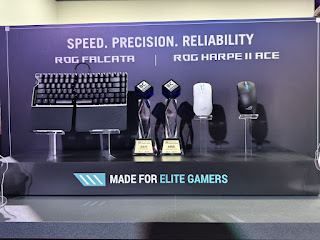Asus Unveils ROG Falcata Split Mechanical Keyboard with Hall Effect Sensors and Harpe 2 Ace Gaming Mouse
Revolutionizing ergonomics and precision for gamers and creators alike.
ASUS Republic of Gamers (ROG) has once again pushed the boundaries of gaming peripherals with the launch of its ROG Falcata split mechanical keyboard and Harpe 2 Ace gaming mouse. Unveiled at a virtual event this week, the duo promises to redefine comfort, customization, and responsiveness for competitive gamers and productivity enthusiasts.
ROG Falcata: A Split Design Built for Endurance
The star of the show, the ROG Falcata, breaks away from traditional keyboard layouts with its split mechanical design, catering to ergonomic preferences and reducing wrist strain during marathon gaming sessions. But the real innovation lies under the hood: Hall Effect sensors replace conventional mechanical switches. These magnetic sensors eliminate physical contact between components, offering near-infinite durability (rated for over 100 million keystrokes) and resistance to dust or moisture.
Gamers can also tweak actuation points on-the-fly via Asus’s Armoury Crate software, allowing adjustments from a hair-trigger 0.1mm to a deeper 4mm press. This flexibility is ideal for titles requiring rapid inputs (like FPS games) or deliberate strokes (MMO macros). The Falcata’s wireless capabilities and RGB lighting add polish to its premium aluminum frame.
For those exploring compact alternatives, a recent review of the G-Sevlow Skoll Mini highlights how smaller form factors can enhance portability without sacrificing performance—a niche the Falcata aims to dominate with its modular design.
Harpe 2 Ace Mouse: Featherlight Precision
Paired with the Falcata is the Harpe 2 Ace, a gaming mouse weighing just 47 grams. Its honeycomb shell ensures breathability during intense use, while the 36,000 DPI optical sensor delivers pixel-perfect tracking. Asus also integrated “Quick Swap” hot-swappable switches, letting users replace Omron mechanical switches in seconds—no soldering required.
The Harpe 2 Ace supports both wired and wireless modes, with a 100-hour battery life in Bluetooth. For comparison, wireless enthusiasts might also appreciate Xiaomi’s MK71 Pro, a budget-friendly mechanical keyboard blending sleek aesthetics with multi-device connectivity.
Industry Impact and Availability
Asus’s focus on Hall Effect technology signals a broader shift toward durability and customization in gaming gear. “The Falcata and Harpe 2 Ace are about empowering users to play longer, smarter, and more comfortably,” said an ROG spokesperson during the launch.
While pricing remains under wraps, the peripherals are expected to hit shelves in Q3 2024. For deeper specs, NotebookCheck’s breakdown offers a detailed look at their technical prowess.
Whether you’re a pro gamer or a design professional, Asus’s latest innovations blend cutting-edge tech with user-centric design—proving that the future of peripherals is both smart and adaptable. Stay tuned for hands-on reviews as the launch approaches! 🎮⌨️










